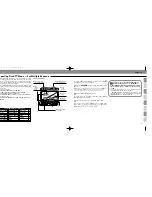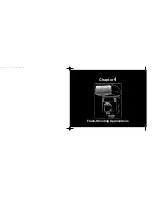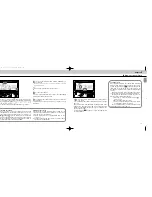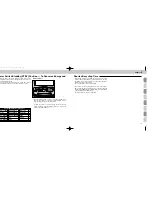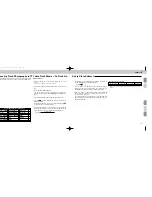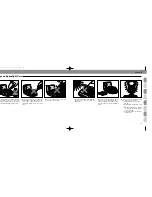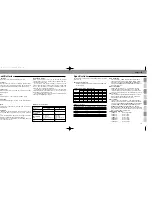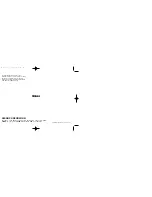
119
118
Chapter
4
The “guide number” helps you determine a correct aperture
or f/stop value for using the SB-25’s Manual Flash and
Repeating-Flash mode. (See “Guide number” chart, page
139.)
Use the following equation for your calculations, and
check the following chart for guide numbers at various film
speeds.
[f/stop] =
[guide number]
[flash-to-subject distance]
For example, when shooting a subject located 9 m
(approx. 30 ft.) away at 1/1 (full) light output in
(Manual
Flash) mode, with a zoom-head position of 35mm and a film
speed of ISO 100, you will obtain a guide number of 36 (or
118) from the same chart on page 139.
If the film speed in the above example was ISO 400 rather
than ISO 100:
[f/stop] =
36
x 2 = 4 x 2 = 8
9
Or, if measuring in feet;
[f/stop] =
118
x 2 = 3.93 x 2 = 7.86
≈
8
30
You should then choose f/8 as the proper aperture.
Adjustment factors for other ISO film speeds
ISO film speed
Factor
25
50
100
200
400
500
1600
x 0.5 x 0.71
x 1
x 1.4
x 2
x 2.8
x 4
If measuring in meters;
[f/stop] =
36
= 4
9
Or, if measuring in feet;
[f/stop] =
118
= 3.93
≈
4
30
You should then choose f/4 as the proper aperture.
For films other than ISO 100, multiply the above figures
by the factors shown in the following chart:
Guide Number —
To Calculate a Proper Aperture
Diffusing Light —
To Soften Harsh Shadows
With a subject in front of a wall, a direct flash causes harsh
and unattractive shadows. By bouncing the light off the ceil-
ing or walls, or by diffusing the light with card(s) or paper,
you can soften harsh shadows and create attractive por-
traits.
The SB-25 comes with a built-in diffuser. You can use it
alone or with a combination of other reflecting surfaces for
advanced application.
There are a few ways to diffuse light:
1. Bounce light off a broad reflective surface such as
the ceiling.
2. Use both the ceiling and the built-in diffuser card to
create a catchlight for subject's eyes.
3. Use a diffuser between the flash and the subject.
1. Light can be bounced off the ceiling.
2. Natural-appearing light
with a pleasing catchlight
in the eyes.
3. Use some translucent
material between the
flash unit and subject.
F90-Series/N90
✗
F-501/N2020
✗
Nikonos V
✗
F4-Series
✗
F-301/N2000
✗
F3-Series
✗
F-801/N8008
✗
F-401/N4004
✗
F2-Series
✗
F-801s/N8008s
✗
F-401s/N4004s
✗
FM2
✗
F-601
M
/N6000
✗
FE2
✗
F-401x/N5005
✗
FG
✗
F-601/N6006
✗
FA
✗
FG-20
✗
APPLICABLE NIKON SLR MODELS
F90-Series/N90
✗
F-501/N2020
✗
Nikonos V
✗
F4-Series
✗
F-301/N2000
✗
F3-Series
✗
F-801/N8008
✗
F-401/N4004
✗
F2-Series
✗
F-801s/N8008s
✗
F-401s/N4004s
✗
FM2
✗
F-601
M
/N6000
✗
FE2
✗
F-401x/N5005
✗
FG
✗
F-601/N6006
✗
FA
✗
FG-20
✗
APPLICABLE NIKON SLR MODELS
SB-25_En 03.1.14 8:18 PM Page 118
Summary of Contents for SB-25
Page 1: ...Instruction Manual E Autofocus Speedlight 25_En 03 1 14 8 18 PM Page 1 ...
Page 4: ...Chapter 1 Introducing the SB 25 Autofocus Speedlight 25_En 03 1 14 8 18 PM Page 6 ...
Page 10: ...Chapter 2 Before Flash Shooting 25_En 03 1 14 8 18 PM Page 18 ...
Page 49: ...Chapter 4 Flash Shooting Applications 25_En 03 1 14 8 18 PM Page 96 ...

